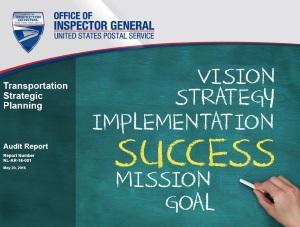Transportation Strategic Planning
Background
In response to declining mail volume, the U.S. Postal Service is challenged with rightsizing its transportation network and adjusting its [redacted], while reducing costs and maintaining delivery service. In fiscal year (FY) 2011, the Postal Service established 36 Delivering Results, Innovation, Value, and Efficiency (DRIVE) initiatives to improve its business strategy. DRIVE aims to bring revenue in line with expenses through strategic initiatives with measurable outcomes. Each initiative has process roadmaps that track whether initiatives remain on schedule and achieve their objectives.
The strategy for rightsizing the transportation network is DRIVE Initiative 1.13, Ground Transportation. This initiative is designed to reduce transportation spending by $1 billion from FY 2014 through FY 2017. In FY 2015, annual network transportation costs of about [redacted] billion were the Postal Service’s largest operating expense after compensation and benefits.
During our audit we did a comparative analysis of strategic planning best practices used by 15 international posts, corporations, and advisory boards. We found that effective strategies include contingency planning.
Our objective was to evaluate the Postal Service’s strategy to effectively optimize its [redacted] network.
What the OIG Found
The Postal Service needs to improve its strategy to optimize its transportation network. DRIVE Initiative 1.13 projected savings through FY 2015 of [redacted] million, or [redacted] percent of the overall $1 billion goal. However, it only realized [redacted] million of those savings.
Specifically, in FY 2014, the Postal Service did not meet projected cost savings in six of its eight Transportation process roadmaps, resulting in a savings shortfall of [redacted] million. In FY 2015, six roadmaps and two more process roadmaps did not meet projected cost savings, resulting in a savings shortfall of [redacted] million. Finally, in Quarter 1, FY 2016, none of the roadmaps realized projected cost savings, resulting in an additional savings shortfall of [redacted] million.
The surface transportation manager said that an [redacted] contributed to the savings shortfall. We are reviewing transportation costs in relation to service standard changes in a separate audit and may review the Postal Service’s progress on transportation savings programs in the future.
In addition, we found the transportation optimization strategy did not have a contingency plan to re-evaluate program process roadmaps when they did not yield the projected savings. Contingency planning helps management mitigate unexpected events and achieve goals.
What the OIG Recommended
We recommended the vice president, Network Operations, update the 1.13 section of DRIVE 1 - Optimize Network Operations to include an achievable projected transportation cost reduction goal and contingency planning to mitigate unexpected events in FYs 2016 and 2017.

